Page 228 of 505
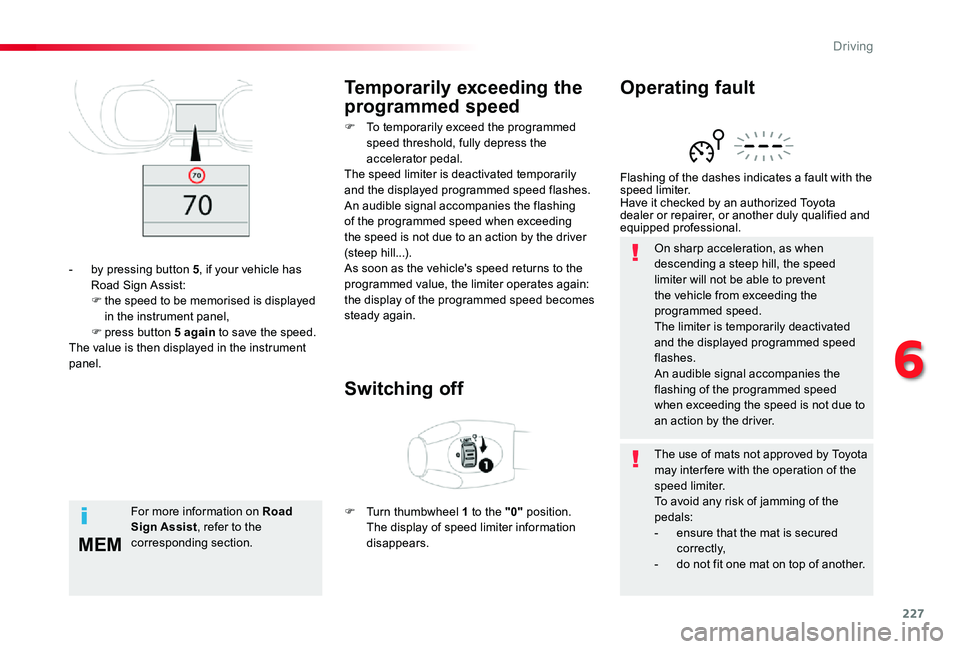
227
MEM
On sharp acceleration, as when descending a steep hill, the speed limiter will not be able to prevent the vehicle from exceeding the programmed speed.The limiter is temporarily deactivated and the displayed programmed speed flashes.An audible signal accompanies the flashing of the programmed speed when exceeding the speed is not due to an action by the driver.
Flashing of the dashes indicates a fault with the speed limiter.Have it checked by an authorized Toyota dealer or repairer, or another duly qualified and equipped professional.
Operating faultTemporarily exceeding the
programmed speed
Switching off
F To temporarily exceed the programmed speed threshold, fully depress the accelerator pedal.The speed limiter is deactivated temporarily and the displayed programmed speed flashes.An audible signal accompanies the flashing of the programmed speed when exceeding the speed is not due to an action by the driver (steep hill...).As soon as the vehicle's speed returns to the programmed value, the limiter operates again: the display of the programmed speed becomes steady again.
F Turn thumbwheel 1 to the "0" position. The display of speed limiter information disappears.
- by pressing button 5, if your vehicle has Road Sign Assist:F the speed to be memorised is displayed in the instrument panel,F press button 5 again to save the speed.The value is then displayed in the instrument panel.
For more information on Road Sign Assist, refer to the corresponding section.
The use of mats not approved by Toyota may inter fere with the operation of the speed limiter.To avoid any risk of jamming of the pedals:- ensure that the mat is secured c o r r e c t l y,- do not fit one mat on top of another.
6
Driving
Page 230 of 505
229
If your vehicle has a manual gearbox, third or fourth gear, or higher, must be engaged.
If your vehicle has an automatic or electronic gearbox, second gear or higher must be engaged.
6. Cruise control pause/resume indication.7. Cruise control mode selection indication.8. Speed value setting.
Display in the instrument panel
Head-up display
Switching on
F Turn thumbwheel 1 to the "CRUISE" position: the cruise control mode is selected but is not switched on (Pause).F Press on button 2 or 3: your vehicle's current speed becomes the cruise speed.The cruise control is activated (ON).
It is possible to exceed the programmed speed temporarily by pressing the accelerator pedal.To return to the programmed speed, simply release the accelerator pedal until the programmed cruise speed is reached again.
The cruise control is switched on manually: it requires a minimum vehicle speed of 25 mph (40 km/h).
6
Driving
Page 232 of 505
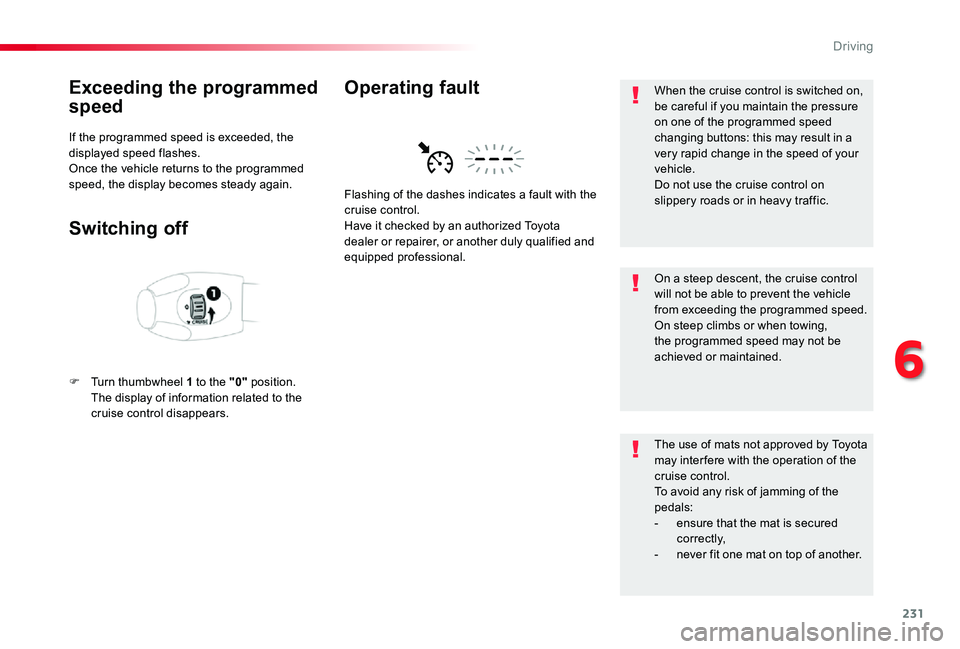
231
Exceeding the programmed
speed
If the programmed speed is exceeded, the displayed speed flashes.Once the vehicle returns to the programmed speed, the display becomes steady again.
Switching off
F Turn thumbwheel 1 to the "0" position. The display of information related to the cruise control disappears.
Flashing of the dashes indicates a fault with the cruise control.Have it checked by an authorized Toyota dealer or repairer, or another duly qualified and equipped professional.
Operating faultWhen the cruise control is switched on, be careful if you maintain the pressure on one of the programmed speed changing buttons: this may result in a very rapid change in the speed of your vehicle.Do not use the cruise control on slippery roads or in heavy traffic.
On a steep descent, the cruise control will not be able to prevent the vehicle from exceeding the programmed speed.On steep climbs or when towing, the programmed speed may not be achieved or maintained.
The use of mats not approved by Toyota may inter fere with the operation of the cruise control.To avoid any risk of jamming of the pedals:- ensure that the mat is secured c o r r e c t l y,- never fit one mat on top of another.
6
Driving
Page 233 of 505
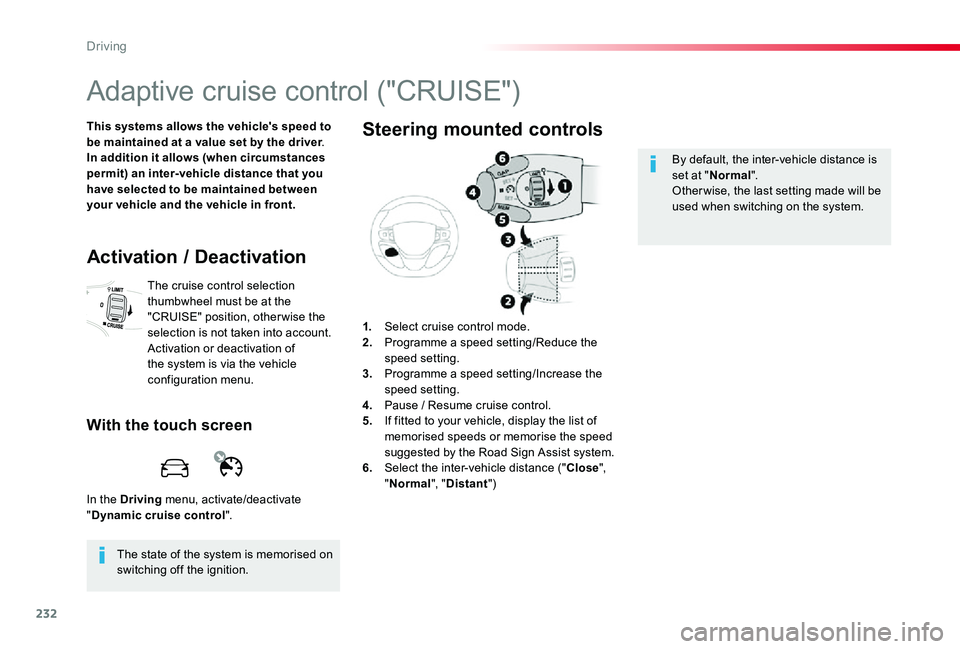
232
Adaptive cruise control ("CRUISE")
This systems allows the vehicle's speed to be maintained at a value set by the driver.In addition it allows (when circumstances permit) an inter-vehicle distance that you have selected to be maintained between your vehicle and the vehicle in front.
In the Driving menu, activate/deactivate "Dynamic cruise control".
The state of the system is memorised on switching off the ignition.
Activation / Deactivation
The cruise control selection thumbwheel must be at the "CRUISE" position, other wise the selection is not taken into account.Activation or deactivation of the system is via the vehicle configuration menu.
With the touch screen
1. Select cruise control mode.2. Programme a speed setting/Reduce the speed setting.3. Programme a speed setting/Increase the speed setting.4. Pause / Resume cruise control.5. If fitted to your vehicle, display the list of memorised speeds or memorise the speed suggested by the Road Sign Assist system.6. Select the inter-vehicle distance ("Close", "Normal", "Distant")
Steering mounted controls
By default, the inter-vehicle distance is set at "Normal".Other wise, the last setting made will be used when switching on the system.
Driving
Page 234 of 505
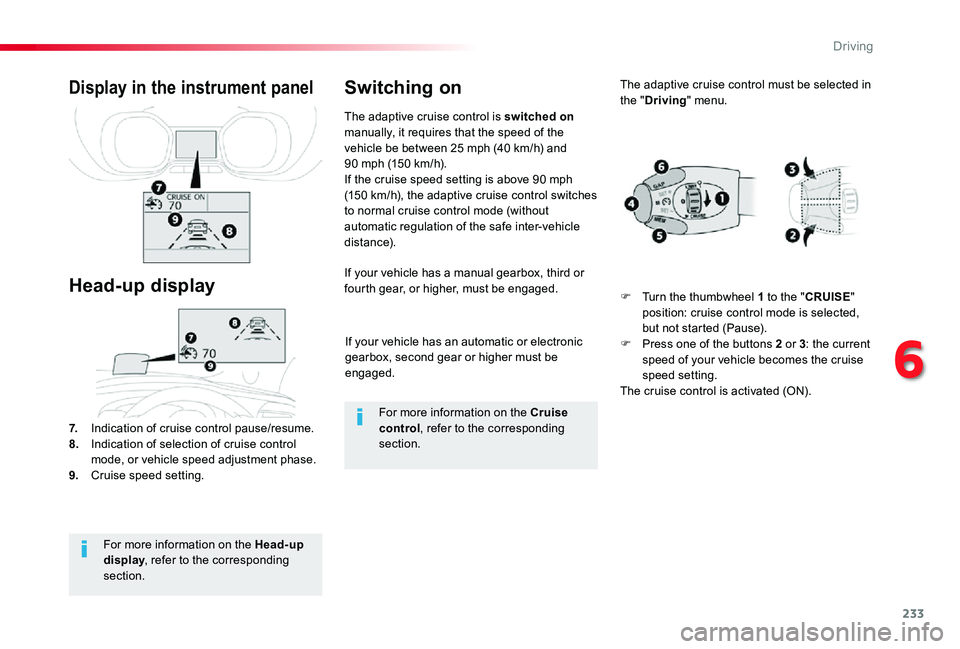
233
If your vehicle has an automatic or electronic gearbox, second gear or higher must be engaged.
If your vehicle has a manual gearbox, third or fourth gear, or higher, must be engaged.
7. Indication of cruise control pause/resume.8. Indication of selection of cruise control mode, or vehicle speed adjustment phase.9. Cruise speed setting.
Display in the instrument panel
Head-up display
The adaptive cruise control is switched on manually, it requires that the speed of the vehicle be between 25 mph (40 km/h) and 90 mph (150 km/h).If the cruise speed setting is above 90 mph (150 km/h), the adaptive cruise control switches to normal cruise control mode (without automatic regulation of the safe inter-vehicle distance).
Switching on
For more information on the Head-up display, refer to the corresponding section.
For more information on the Cruise control, refer to the corresponding section.
The adaptive cruise control must be selected in the "Driving" menu.
F Turn the thumbwheel 1 to the "CRUISE" position: cruise control mode is selected, but not started (Pause).F Press one of the buttons 2 or 3: the current speed of your vehicle becomes the cruise speed setting.The cruise control is activated (ON).
6
Driving
Page 241 of 505
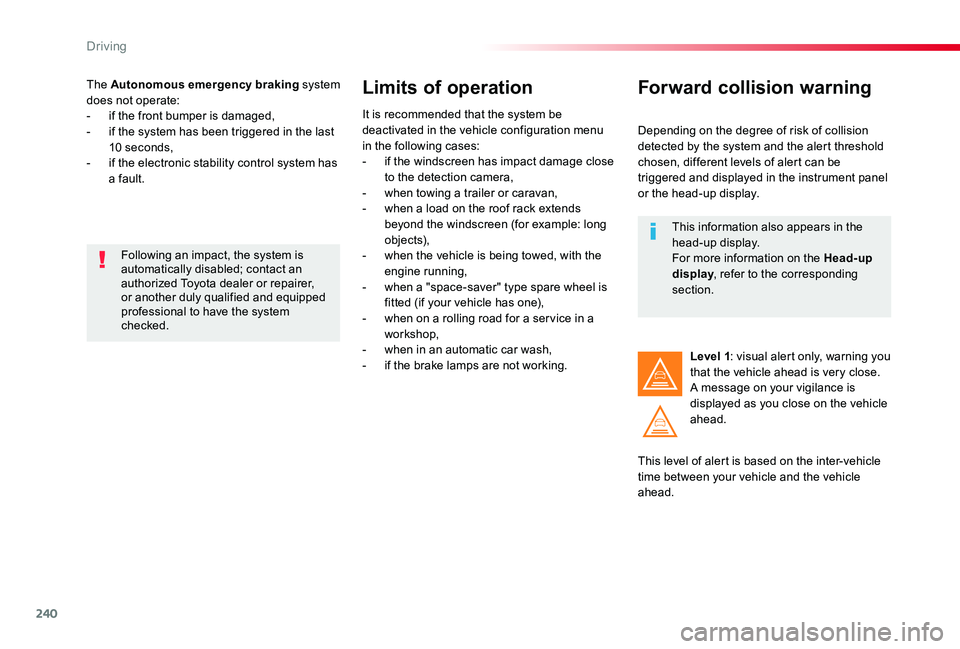
240
The Autonomous emergency braking system does not operate:- if the front bumper is damaged,- if the system has been triggered in the last 10 seconds,- if the electronic stability control system has a fault.
Limits of operation
It is recommended that the system be deactivated in the vehicle configuration menu in the following cases:- if the windscreen has impact damage close to the detection camera,- when towing a trailer or caravan,- when a load on the roof rack extends beyond the windscreen (for example: long objects),- when the vehicle is being towed, with the engine running,- when a "space-saver" type spare wheel is fitted (if your vehicle has one),- when on a rolling road for a ser vice in a workshop,- when in an automatic car wash,- if the brake lamps are not working.
Following an impact, the system is automatically disabled; contact an authorized Toyota dealer or repairer, or another duly qualified and equipped professional to have the system checked.
Forward collision warning
Depending on the degree of risk of collision detected by the system and the alert threshold chosen, different levels of alert can be triggered and displayed in the instrument panel or the head-up display.
This level of alert is based on the inter-vehicle time between your vehicle and the vehicle ahead.
Level 1: visual alert only, warning you that the vehicle ahead is very close.A message on your vigilance is displayed as you close on the vehicle ahead.
This information also appears in the head-up display.For more information on the Head-up display, refer to the corresponding section.
Driving
Page 243 of 505
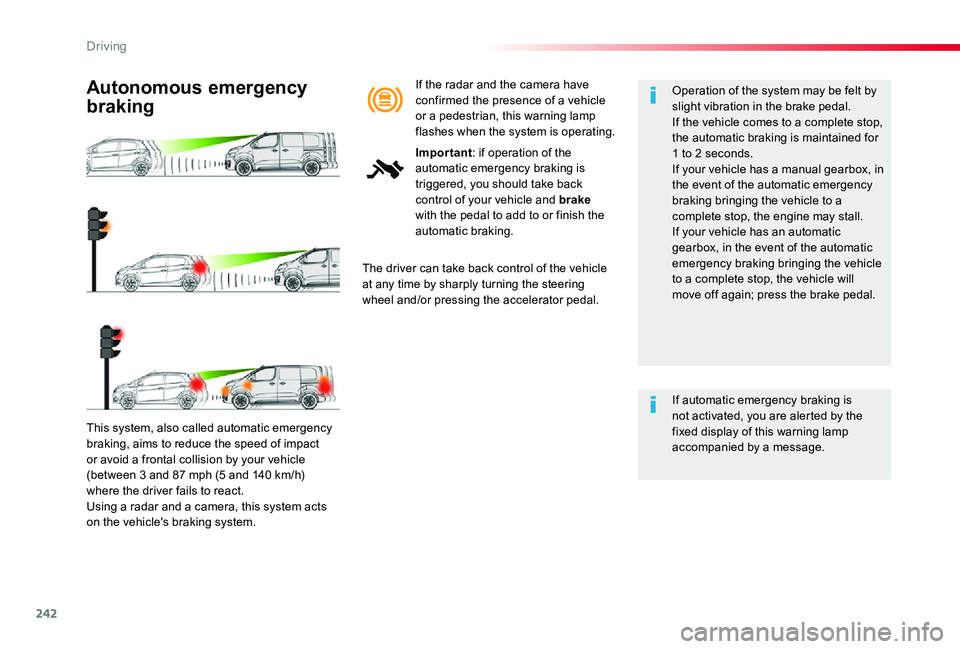
242
This system, also called automatic emergency braking, aims to reduce the speed of impact or avoid a frontal collision by your vehicle (between 3 and 87 mph (5 and 140 km/h) where the driver fails to react.Using a radar and a camera, this system acts on the vehicle's braking system.
Autonomous emergency
braking
The driver can take back control of the vehicle at any time by sharply turning the steering wheel and/or pressing the accelerator pedal.
Operation of the system may be felt by slight vibration in the brake pedal.If the vehicle comes to a complete stop, the automatic braking is maintained for 1 to 2 seconds.If your vehicle has a manual gearbox, in the event of the automatic emergency braking bringing the vehicle to a complete stop, the engine may stall.If your vehicle has an automatic gearbox, in the event of the automatic emergency braking bringing the vehicle to a complete stop, the vehicle will move off again; press the brake pedal.
If automatic emergency braking is not activated, you are alerted by the fixed display of this warning lamp accompanied by a message.
If the radar and the camera have confirmed the presence of a vehicle or a pedestrian, this warning lamp flashes when the system is operating.
Important: if operation of the automatic emergency braking is triggered, you should take back control of your vehicle and brake with the pedal to add to or finish the automatic braking.
Driving
Page 248 of 505
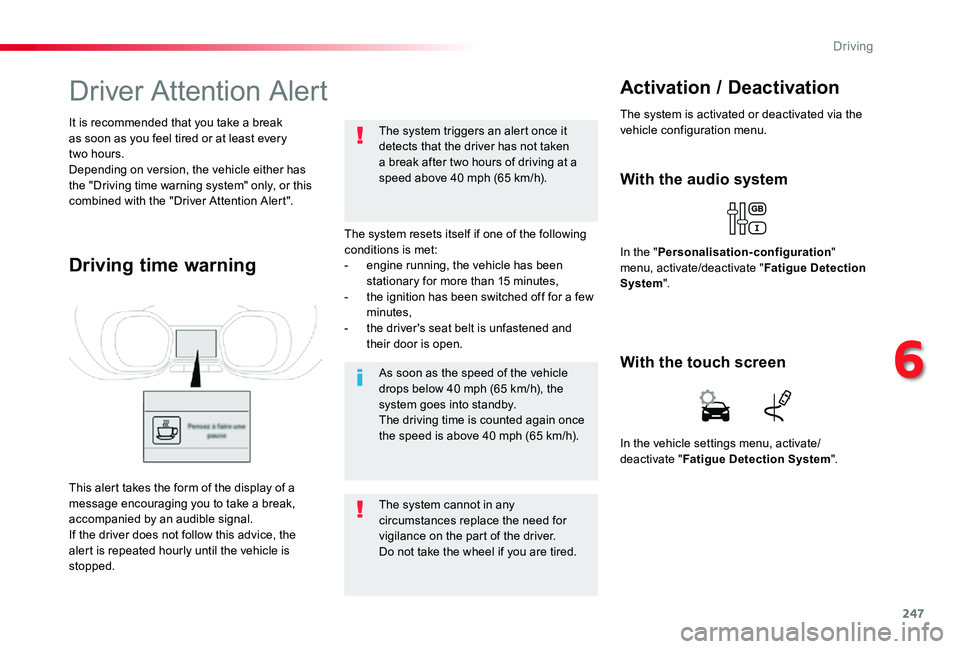
247
Driver Attention Alert
The system resets itself if one of the following conditions is met:- engine running, the vehicle has been stationary for more than 15 minutes,- the ignition has been switched off for a few minutes,- the driver's seat belt is unfastened and their door is open.
As soon as the speed of the vehicle drops below 40 mph (65 km/h), the system goes into standby.The driving time is counted again once the speed is above 40 mph (65 km/h).
The system cannot in any circumstances replace the need for vigilance on the part of the driver.
Do not take the wheel if you are tired.
The system triggers an alert once it detects that the driver has not taken a break after two hours of driving at a speed above 40 mph (65 km/h).
It is recommended that you take a break as soon as you feel tired or at least every two hours.Depending on version, the vehicle either has the "Driving time warning system" only, or this combined with the "Driver Attention Alert".
Driving time warning
With the audio system
In the "Personalisation-configuration" menu, activate/deactivate "Fatigue Detection System".
Activation / Deactivation
The system is activated or deactivated via the vehicle configuration menu.
This alert takes the form of the display of a message encouraging you to take a break, accompanied by an audible signal.If the driver does not follow this advice, the alert is repeated hourly until the vehicle is stopped.
In the vehicle settings menu, activate/
deactivate "Fatigue Detection System".
With the touch screen
6
Driving